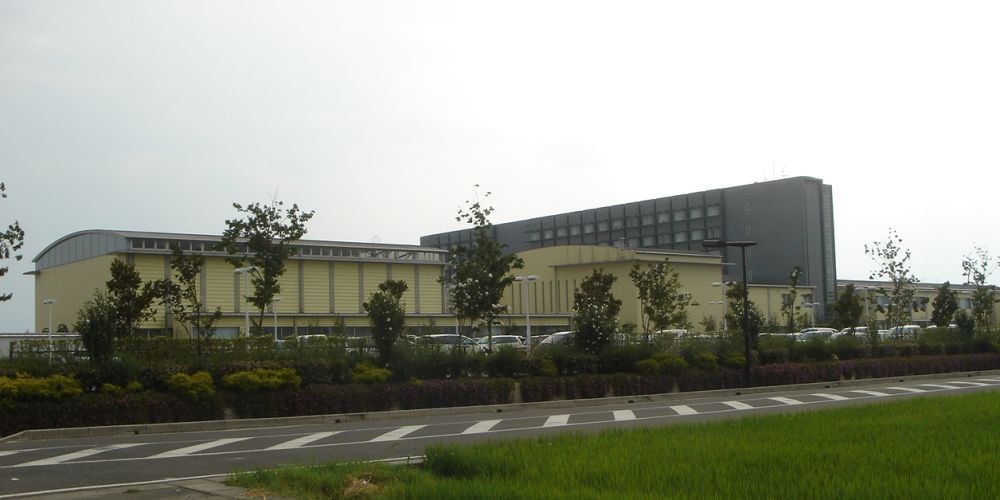|
Gifu-Hashima Station
is a railway station on the Tokaido Shinkansen located in the city of Hashima, Gifu, Japan, operated by Central Japan Railway Company (JR Central). It is the sole Shinkansen station in Gifu Prefecture. Lines Gifu-Hashima Station is served only by the Tokaido Shinkansen, and is located from the terminus of the line at . Shin-Hashima Station, the terminal of the Meitetsu Hashima Line is located in front of the Shinkansen station and provides railway access to the city of Gifu. Station layout The station has two island platforms serving four tracks, with two additional centre tracks for non-stop passing trains. The station has a ''Midori no Madoguchi'' staffed ticket office. Platforms History The station opened on October 1, 1964. With the privatization and dissolution of Japanese National Railways on April 1, 1987, the station came under the control of JR Central. Surrounding area * Gifu College of Nursing See also *List of railway stations in Japan The links below co ... [...More Info...] [...Related Items...] OR: [Wikipedia] [Google] [Baidu] |
Gifu Prefecture
is a prefecture of Japan located in the Chūbu region of Honshu. Gifu Prefecture has a population of 1,991,390 () and has a geographic area of . Gifu Prefecture borders Toyama Prefecture to the north; Ishikawa Prefecture to the northwest, Fukui Prefecture and Shiga Prefecture to the west, Mie Prefecture to the southwest, Aichi Prefecture to the south, and Nagano Prefecture to the east. Gifu is the capital and largest city of Gifu Prefecture, with other major cities including Ōgaki, Kakamigahara, and Tajimi. Gifu Prefecture is located in the center of Japan, one of only eight landlocked prefectures, and features the country's center of population. Gifu Prefecture has served as the historic crossroads of Japan with routes connecting the east to the west, including the Nakasendō, one of the Five Routes of the Edo period. Gifu Prefecture was a long-term residence of Oda Nobunaga and Saitō Dōsan, two influential figures of Japanese history in the Sengoku period, spawning ... [...More Info...] [...Related Items...] OR: [Wikipedia] [Google] [Baidu] |
Meitetsu Hashima Line
The is a Japanese railway line entirely within Hashima, Gifu Prefecture. It is owned by Nagoya Railroad (Meitetsu), and operated as an extension of the Takehana line, providing a connection to the Tokaido Shinkansen at Gifu-Hashima Station is a railway station on the Tokaido Shinkansen located in the city of Hashima, Gifu, Japan, operated by Central Japan Railway Company (JR Central). It is the sole Shinkansen station in Gifu Prefecture. Lines Gifu-Hashima Station is served only .... History Proposed in 1962, land acquisition difficulties prevented construction starting until 1978, and the line opened in 1982. Stations External links * References This article incorporates material from the corresponding article in the Japanese Wikipedia {{Nagoya transit Rail transport in Gifu Prefecture Hashima Line Railway lines opened in 1982 1067 mm gauge railways in Japan 1982 establishments in Japan ... [...More Info...] [...Related Items...] OR: [Wikipedia] [Google] [Baidu] |
Railway Stations In Japan Opened In 1964
Rail transport (also known as train transport) is a means of transport that transfers passengers and goods on wheeled vehicles running on rails, which are incorporated in tracks. In contrast to road transport, where the vehicles run on a prepared flat surface, rail vehicles ( rolling stock) are directionally guided by the tracks on which they run. Tracks usually consist of steel rails, installed on sleepers (ties) set in ballast, on which the rolling stock, usually fitted with metal wheels, moves. Other variations are also possible, such as "slab track", in which the rails are fastened to a concrete foundation resting on a prepared subsurface. Rolling stock in a rail transport system generally encounters lower frictional resistance than rubber-tyred road vehicles, so passenger and freight cars (carriages and wagons) can be coupled into longer trains. The operation is carried out by a railway company, providing transport between train stations or freight customer faci ... [...More Info...] [...Related Items...] OR: [Wikipedia] [Google] [Baidu] |
Railway Stations In Gifu Prefecture
Rail transport (also known as train transport) is a means of transport that transfers passengers and goods on wheeled vehicles running on rails, which are incorporated in tracks. In contrast to road transport, where the vehicles run on a prepared flat surface, rail vehicles (rolling stock) are directionally guided by the tracks on which they run. Tracks usually consist of steel rails, installed on sleepers (ties) set in ballast, on which the rolling stock, usually fitted with metal wheels, moves. Other variations are also possible, such as "slab track", in which the rails are fastened to a concrete foundation resting on a prepared subsurface. Rolling stock in a rail transport system generally encounters lower frictional resistance than rubber-tyred road vehicles, so passenger and freight cars (carriages and wagons) can be coupled into longer trains. The operation is carried out by a railway company, providing transport between train stations or freight customer facili ... [...More Info...] [...Related Items...] OR: [Wikipedia] [Google] [Baidu] |
List Of Railway Stations In Japan ...
The links below contain all of the 8579 railway stations in Japan. External links {{Portal bar, Japan, Trains * Railway stations Japan Japan ( ja, 日本, or , and formally , ''Nihonkoku'') is an island country in East Asia. It is situated in the northwest Pacific Ocean, and is bordered on the west by the Sea of Japan, while extending from the Sea of Okhotsk in the north ... [...More Info...] [...Related Items...] OR: [Wikipedia] [Google] [Baidu] |
Gifu College Of Nursing
is a public university at Hashima, Gifu, Japan Japan ( ja, 日本, or , and formally , ''Nihonkoku'') is an island country in East Asia. It is situated in the northwest Pacific Ocean, and is bordered on the west by the Sea of Japan, while extending from the Sea of Okhotsk in the north ..., established in 2000. External links Official website Educational institutions established in 2000 Public universities in Japan Universities and colleges in Gifu Prefecture Nursing schools in Japan Hashima, Gifu 2000 establishments in Japan {{gifu-university-stub ... [...More Info...] [...Related Items...] OR: [Wikipedia] [Google] [Baidu] |
Japanese National Railways
The abbreviated JNR or , was the business entity that operated Japan's national railway network from 1949 to 1987. Network Railways As of June 1, 1949, the date of establishment of JNR, it operated of narrow gauge () railways in all 46 prefectures of Japan. This figure expanded to in 1981 (excluding Shinkansen), but later reduced to as of March 31, 1987, the last day of JNR. JNR operated both passenger and freight services. Shinkansen Shinkansen, the world's first high-speed railway was debuted by JNR in 1964. By the end of JNR in 1987, four lines were constructed: ; Tōkaidō Shinkansen: , completed in 1964 ; Sanyō Shinkansen: , completed in 1975 ; Tōhoku Shinkansen: , as of 1987 ; Jōetsu Shinkansen: , completed in 1982 Buses JNR operated bus lines as feeders, supplements or substitutions of railways. Unlike railway operation, JNR Bus was not superior to other local bus operators. The JR Bus companies are the successors of the bus operation of JNR. Ships JNR o ... [...More Info...] [...Related Items...] OR: [Wikipedia] [Google] [Baidu] |
Island Platform
An island platform (also center platform, centre platform) is a station layout arrangement where a single platform is positioned between two tracks within a railway station, tram stop or transitway interchange. Island platforms are popular on twin-track routes due to pragmatic and cost reasons. They are also useful within larger stations where local and express services for the same direction of travel can be provided from opposite sides of the same platform thereby simplifying transfers between the two tracks. An alternative arrangement is to position side platforms on either side of the tracks. The historical use of island platforms depends greatly upon the location. In the United Kingdom the use of island platforms is relatively common when the railway line is in a cutting or raised on an embankment, as this makes it easier to provide access to the platform without walking across the tracks. Advantages and tradeoffs Island platforms are necessary for any station with many th ... [...More Info...] [...Related Items...] OR: [Wikipedia] [Google] [Baidu] |
Gifu
is a city located in the south-central portion of Gifu Prefecture, Japan, and serves as the prefectural capital. The city has played an important role in Japan's history because of its location in the middle of the country. During the Sengoku period, various warlords, including Oda Nobunaga, used the area as a base in an attempt to unify and control Japan. Gifu continued to flourish even after Japan's unification as both an important '' shukuba'' along the Edo period NakasendōNakasendo to Shukuba-machi Gifu City Hall. Accessed September 9, 2007. and, later, as one of Japan's fashion centers. It has been designated a by the national government. Overview |
Shin-Hashima Station
is a railway station located in the city of Hashima, Gifu Prefecture, Japan, operated by the private railway operator Meitetsu. It is located in front of Gifu-Hashima Station on the Tōkaidō Shinkansen and allows passengers to go from the high speed train network to the Nagoya Railroad (Meitetsu) network and vice versa, but in practice most passengers to or from Gifu choose to enter or leave the high speed train network at Nagoya Station. Lines Shin Hashima Station is a station on the Hashima Line, and is located 1.3 kilometers from the terminus of the Hashima Line at and is 11.6 kilometers from . Station layout Shin Hashima Station has one ground-level side platform serving a single bi-directional track. The station is unattended. Platforms Adjacent stations History Shin Hashima Station opened on 12 December 1982. Surrounding area *Gifu College of Nursing See also * List of Railway Stations in Japan The links below contain all of the 8579 railway stations in J ... [...More Info...] [...Related Items...] OR: [Wikipedia] [Google] [Baidu] |
Island Platforms
An island platform (also center platform, centre platform) is a station layout arrangement where a single platform is positioned between two tracks within a railway station, tram stop or transitway interchange. Island platforms are popular on twin-track routes due to pragmatic and cost reasons. They are also useful within larger stations where local and express services for the same direction of travel can be provided from opposite sides of the same platform thereby simplifying transfers between the two tracks. An alternative arrangement is to position side platforms on either side of the tracks. The historical use of island platforms depends greatly upon the location. In the United Kingdom the use of island platforms is relatively common when the railway line is in a cutting or raised on an embankment, as this makes it easier to provide access to the platform without walking across the tracks. Advantages and tradeoffs Island platforms are necessary for any station with many th ... [...More Info...] [...Related Items...] OR: [Wikipedia] [Google] [Baidu] |
Central Japan Railway Company
is the main railway company operating in the Chūbu (Nagoya) region of central Japan. It is officially abbreviated in English as JR Central and in Japanese as JR Tōkai ( ja, JR東海, links=no). ''Tōkai'' is a reference to the geographical region in which the company chiefly operates. JR Central's operational hub is Nagoya Station and the company's administrative headquarters are located in the JR Central Towers above the station. The busiest and longest railway line operated by JR Central is the Tōkaidō Main Line between and . The company also operates the Tōkaidō Shinkansen between and . Additionally it is responsible for the Chūō Shinkansen—a maglev service between Tokyo and Osaka, which is due to start operation between Tokyo and Nagoya in 2027. JR Central is Japan's most profitable and highest throughput high-speed-rail operator, carrying 138 million high-speed-rail passengers in 2009, considerably more than the world's largest airline. Japan recorded a ... [...More Info...] [...Related Items...] OR: [Wikipedia] [Google] [Baidu] |






_05.jpg)
